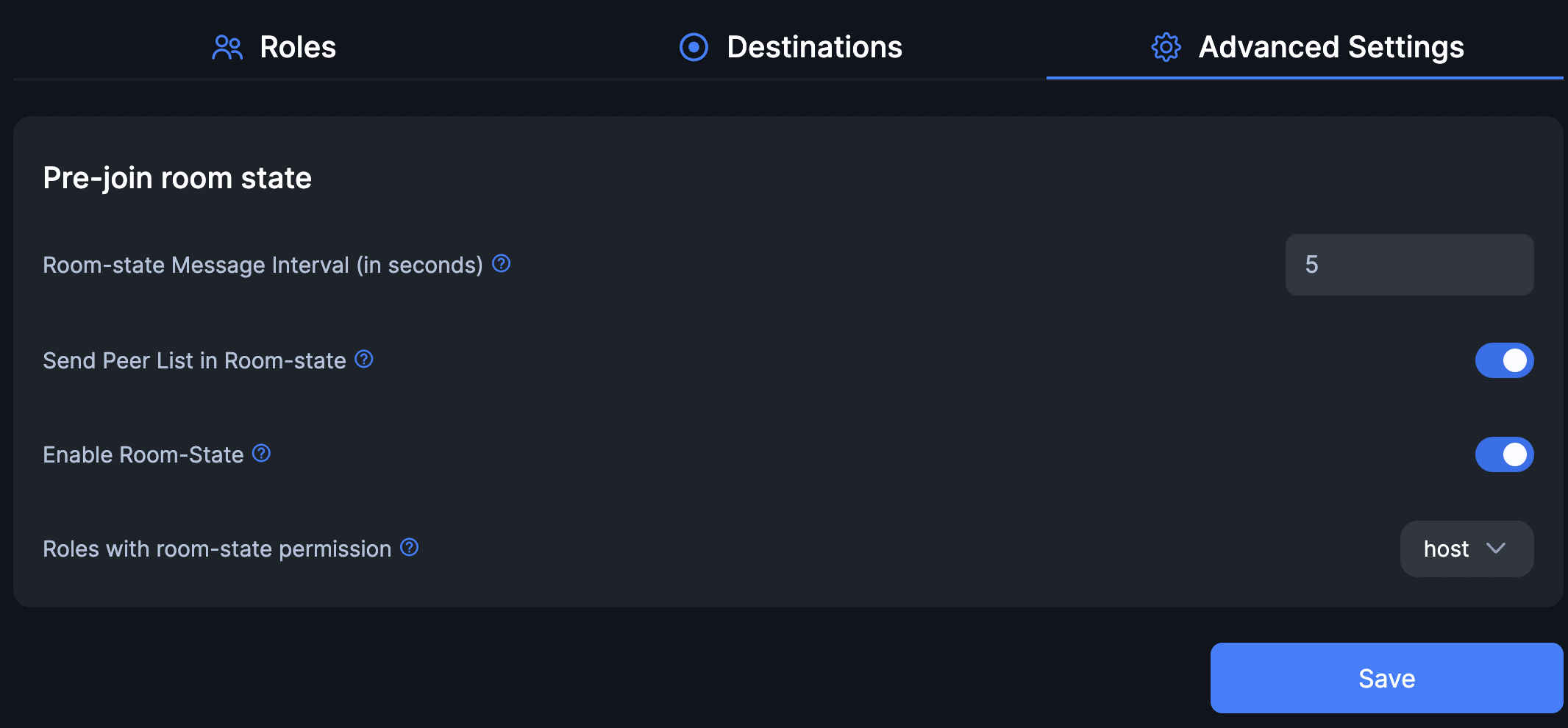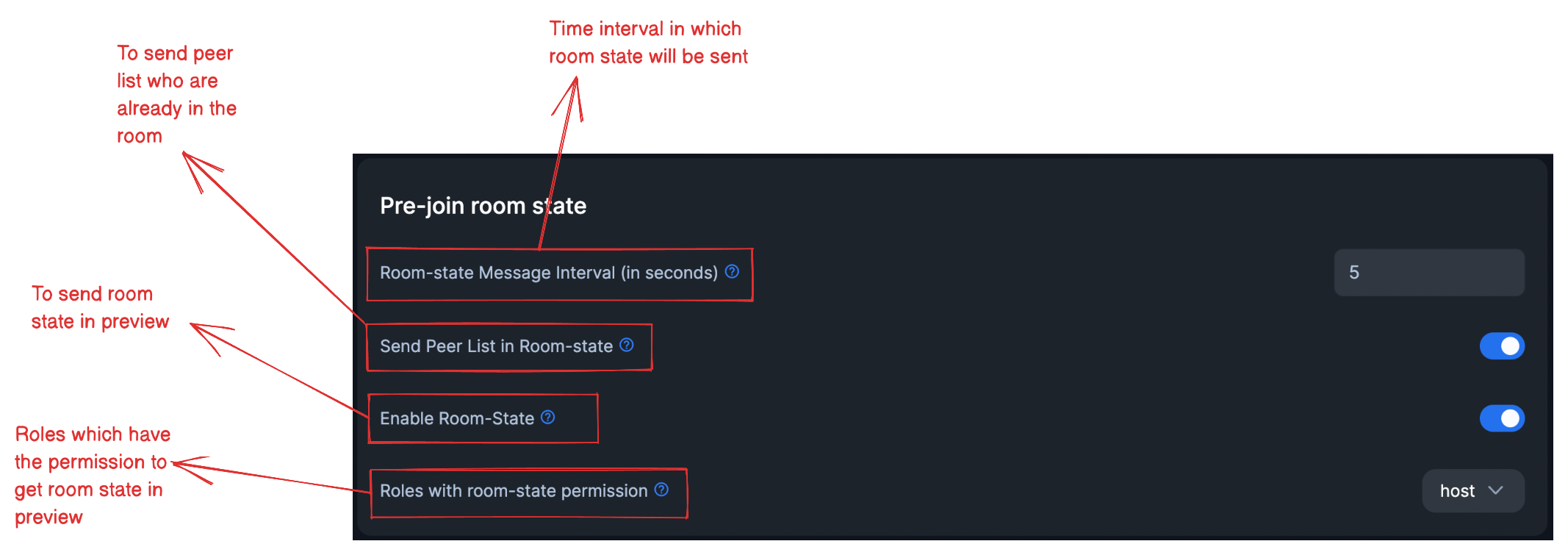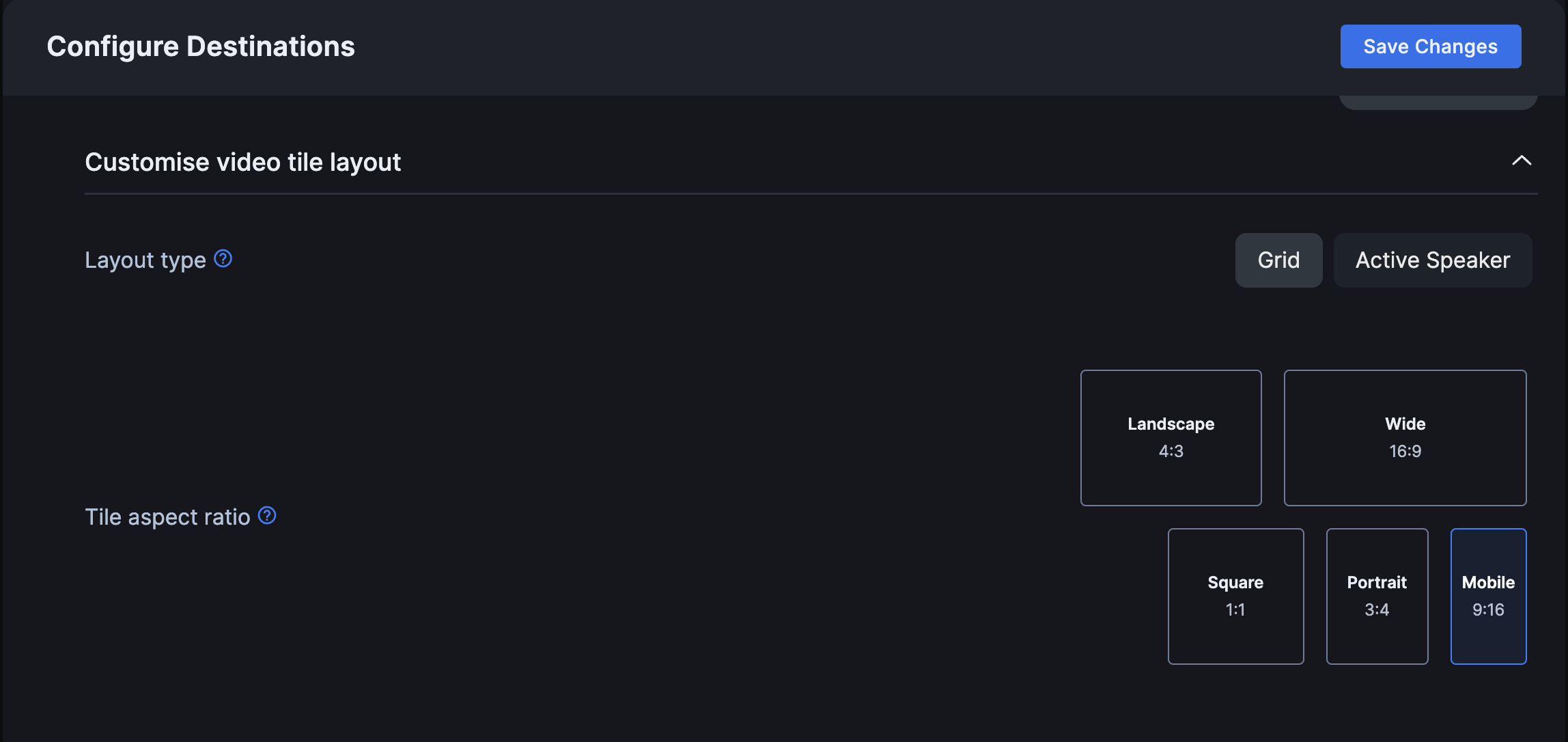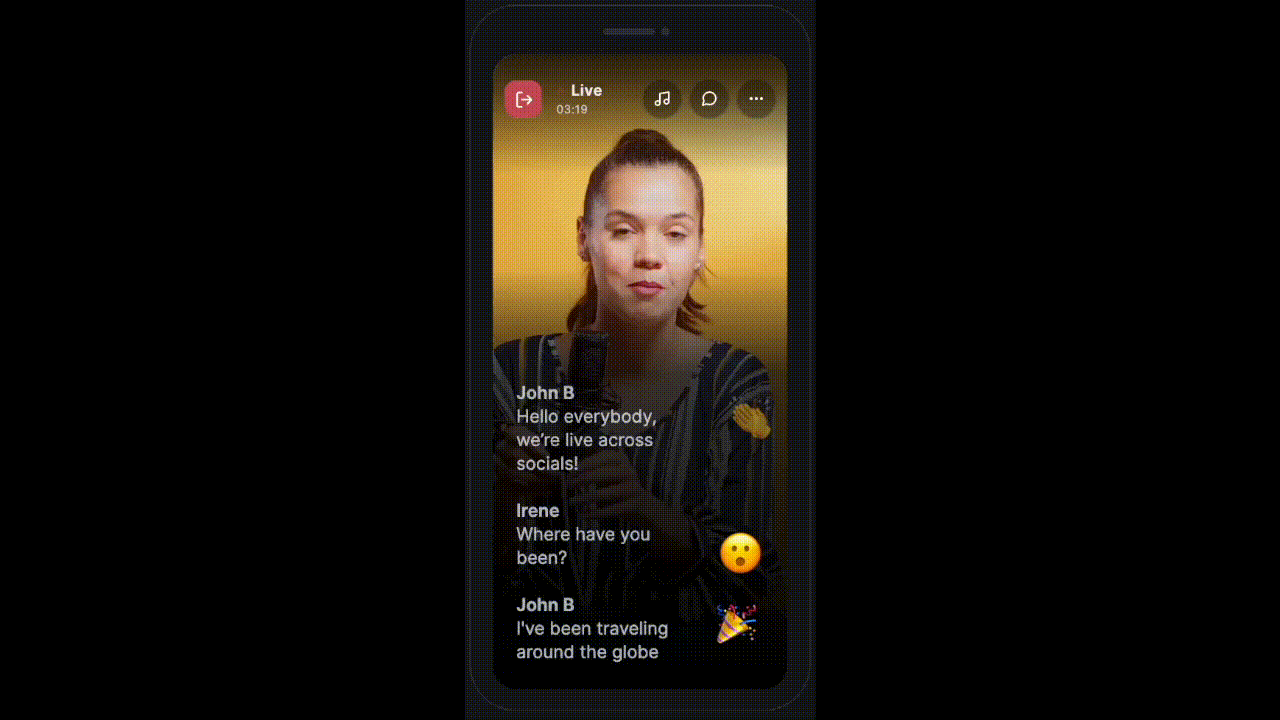HLS Streaming
HLS Streaming allows for scaling to millions of viewers in near real-time. We can give a link of our web app that will be converted to an HLS feed by our server and can be played across devices for consumption.
Behind the scenes, this will be achieved by having a bot join our room and stream what it sees and hears. Once the feed is ready, the server will give a URL that can be played using any HLS Player.
Note that the media server serving the content in this case is owned by 100ms. If looking for a way to stream on YouTube, Twitch etc., please have a look at our RTMP streaming docs here.
Start/Stop HLS
HLS can be started in two ways depending on the level of customization we need.
-
Default View: The simplest view to just begin a stream with default UI and parameters.
-
Custom Views: To use our own UI for HLS streaming, we need to provide our web-app URL for our bot to join and stream. Also, we can record the stream.
Default View
Begins a stream with default parameters.
To start HLS with Default View, call hmsSDK.startHlsStreaming method.
class Meeting implements HMSUpdateListener, HMSActionResultListener{ ... void startHLSStreaming(){ ///[hmsActionResultListener]: an instance of a class that implements HMSActionResultListener //Here this is an instance of a class that implements HMSActionResultListener, that is, Meeting hmsSDK.startHlsStreaming(hmsActionResultListener: this); } void stopHLSStreaming(){ ///[hmsActionResultListener]: an instance of a class that implements HMSActionResultListener //Here this is an instance of a class that implements HMSActionResultListener, that is, Meeting hmsSDK.stopHlsStreaming(hmsActionResultListener: this); } void onSuccess( {HMSActionResultListenerMethod methodType = HMSActionResultListenerMethod.unknown, Map<String, dynamic>? arguments}) { switch (methodType) { ... case HMSActionResultListenerMethod.hlsStreamingStarted: //HLS Started successfully break; case HMSActionResultListenerMethod.hlsStreamingStopped: //HLS Stopped successfully break; } } void onException( {HMSActionResultListenerMethod methodType = HMSActionResultListenerMethod.unknown, Map<String, dynamic>? arguments, required HMSException hmsException}) { switch (methodType) { ... case HMSActionResultListenerMethod.hlsStreamingStarted: // Check the HMSException object for details about the error break; case HMSActionResultListenerMethod.hlsStreamingStopped: // Check the HMSException object for details about the error break; } } }
Custom View
To use our own browser UI for HLS, we'll need to pass in a meeting URL. The 100ms bot will open this URL to join our room, so it must allow access without any user-level interaction.
We can call hmsSDK.startHLSStreaming with an HMSHLSConfig parameter.
Let's look at its structure:
// this is the HLS config class class HMSHLSConfig { List<HMSHLSMeetingURLVariant>? meetingURLVariant; HMSHLSRecordingConfig? hmsHLSRecordingConfig; }
Let's look at its attributes one by one:
meetingURLVariant
This is a list of HMSHLSMeetingURLVariant objects. In the future, it'll be possible to start HLS for multiple such URLs for the same room. So it's a list but currently, only the first element of the list is used.
The HMSHLSMeetingURLVariant class looks like this:
class HMSHLSMeetingURLVariant { String? meetingUrl; String metadata; }
- meetingUrl - URL of the meeting we wish to record
- metadata - Metadata(Any extra info to identify the URL) we wish to pass with the URL.
Let's look at how we can create an HMSHLSMeetingURLVariant and add it in meetingURLVariant :
List<HMSHLSMeetingURLVariant>? meetingURLVariant = []; HMSHLSMeetingURLVariant hlsUrlVariant = HMSHLSMeetingURLVariant( meetingUrl: "Meeting URL of the room", metadata: "HLS started from Flutter"); meetingURLVariant.add(hlsUrlVariant);
hmsHLSRecordingConfig
To record the HLS stream we may specify an HMSHLSRecordingConfig within the HMSHLSConfig.
Here's what the HMSHlsRecordingConfig class looks like -
class HMSHLSRecordingConfig { bool singleFilePerLayer; bool videoOnDemand; }
-
singleFilePerLayer: If the desired end result is a mp4 file per HLS layer, false by default.
-
enableVOD: If the desired result is a zip of m3u8 and all the chunks, false by default.
Here's an example of how to create a recording config & start HLS Streaming with Recording -
HMSHLSRecordingConfig recordingConfig = HMSHLSRecordingConfig(singleFilePerLayer: false, videoOnDemand: true);
This can be passed in HMSHLSConfig to start recording.
Let's see the complete implementation of HLS streaming with recording turned ON:
class Meeting implements HMSUpdateListener, HMSActionResultListener{ ... void startHLSStreaming(String meetingUrl){ List<HMSHLSMeetingURLVariant>? meetingURLVariant = []; HMSHLSMeetingURLVariant hlsUrlVariant = HMSHLSMeetingURLVariant( meetingUrl: meetingUrl, metadata: "HLS started from Flutter"); meetingURLVariant.add(hlsUrlVariant); //This config enables recording with streaming HMSHLSRecordingConfig recordingConfig = HMSHLSRecordingConfig(singleFilePerLayer: false, videoOnDemand: true); HMSHLSConfig hlsConfig = HMSHLSConfig( meetingURLVariant: meetingURLVariant, hmsHLSRecordingConfig: hmshlsRecordingConfig); ///[hmshlsConfig]: an instance of HMSHLSConfig which we created above ///[hmsActionResultListener]: an instance of a class that implements HMSActionResultListener //Here this is an instance of a class that implements HMSActionResultListener, that is, Meeting hmsSDK.startHlsStreaming(hmshlsConfig: hlsConfig,hmsActionResultListener: this); } void stopHLSStreaming(){ ///[hmsActionResultListener]: an instance of a class that implements HMSActionResultListener //Here this is an instance of a class that implements HMSActionResultListener, that is, Meeting hmsSDK.stopHlsStreaming(hmsActionResultListener: this); } void onSuccess( {HMSActionResultListenerMethod methodType = HMSActionResultListenerMethod.unknown, Map<String, dynamic>? arguments}) { switch (methodType) { ... case HMSActionResultListenerMethod.hlsStreamingStarted: //HLS Started successfully break; case HMSActionResultListenerMethod.hlsStreamingStopped: //HLS Stopped successfully break; } } void onException( {HMSActionResultListenerMethod methodType = HMSActionResultListenerMethod.unknown, Map<String, dynamic>? arguments, required HMSException hmsException}) { switch (methodType) { ... case HMSActionResultListenerMethod.hlsStreamingStarted: // Check the HMSException object for details about the error break; case HMSActionResultListenerMethod.hlsStreamingStopped: // Check the HMSException object for details about the error break; } } }
How to display HLS stream and get HLS state in room
The current status of the room is always reflected in the HMSRoom object.
Here are the relevant properties inside the HMSRoom object which we can read to get the current HLS streaming status of the room namely: hlsStreamingState.
The object contains a boolean running which lets us know if HLS is running in the room right now
Also, it contains the m3u8 URL which we will use to display HLS on the screen.
Just like this:
class Meeting implements HMSUpdateListener, HMSActionResultListener{ ... void onRoomUpdate({required HMSRoom room, required HMSRoomUpdate update}) { ... /// this contains info about whether HLS is running in the room or not /// bool isHLSRunning = room.hmshlsStreamingState?.state == HMSStreamingState.started; /// this contains the m3u8 URL if the HLS stream is running /// This URL can be passed to the video player to display HLS Stream. String? hlsm3u8Url = hmshlsStreamingState?.variants[0]?.hlsStreamUrl ... } }
isHLSRunning can be used to show the live stream status on UI something similar to this:

hlsm3u8Url string shown above contains the m3u8 URL which can be used to display HLS Stream.
When to check for room status
The room status should be checked in the following places -
- In the
onJoin(room: HMSRoom)callback ofHMSUpdateListenerThe properties mentioned above will be on theHMSRoomobject. - In the
onRoomUpdate(type: HMSRoomUpdate, hmsRoom: HMSRoom)callback ofHMSUpdateListener. TheHMSRoomUpdatetype will beHMSRoomUpdate.HLS_STREAMING_STATE_UPDATED.
How to make the HLS peers join room faster
Since HLS peers don't publish or subscribe anything there is no point in waiting for onJoin or onTrackUpdate updates
to start showing them the stream as stream only needs the m3u8 URL. This time reduction might not be observed in small rooms
but is extremely helpful in larger rooms.
Let's see how we can make this faster for peers joining with HLS roles:
- Enable room state in preview from dashboard and ensure that the HLS peer is subscribed for the update as.

These options are available in advanced settings:

In the Roles with room-state permission ensure that HLS role is checked to receive the updates.
- Add Preview in the application before the
joinmethod call and attachHMSPreviewListenerto listen toonRoomUpdate
class Preview implements HMSPreviewListener{ late HMSSDK hmsSDK; String? hlsStreamURL = null Preview(){ initHMSSDK(); } void initHMSSDK() async { hmsSDK = HMSSDK(); await hmsSDK.build(); // ensure to await while invoking the `build` method HMSConfig config = HMSConfig( userName: "John Doe", authToken: "eyJH5c", // client-side token generated from your token service ); //Here this is an instance of a class that implements HMSPreviewListener, that is, Preview hmsSDK.addPreviewListener(listener:this); hmsSDK.preview(config: config); } void onPreview({required HMSRoom room, required List<HMSTrack> localTracks}) { //We will get the callback here if the preview succeeds } void onRoomUpdate({required HMSRoom room, required HMSRoomUpdate update}) { switch (update) { ... case HMSRoomUpdate.hlsRecordingStateUpdated: isRecordingStarted = room.hmshlsRecordingState?.state == HMSRecordingState.started; break; case HMSRoomUpdate.rtmpStreamingStateUpdated: isRTMPStreamingStarted = room.hmsRtmpStreamingState?.state == HMSStreamingState.started; break; case HMSRoomUpdate.hlsStreamingStateUpdated: isHLSStreamingStarted = room.hmshlsStreamingState?.state == HMSStreamingState.started;; //This will contain the m3u8 URL if the HLS streaming is already running in the room //We will use this URL to directly play the stream in player once participant joins the room //rather than waiting for the onRoomUpdate callback in meeting. if(isHLSStreamingStarted){ hlsStreamURL = room.hmshlsStreamingState?.variants[0]?.hlsStreamUrl; } break; ... default: break; } } void onPeerUpdate( {required HMSPeer peer, required HMSPeerUpdate update}) async { //Peer updates: https://www.100ms.live/docs/flutter/v2/features/update-listener-enums#hms-peer-update } void onHMSError({required HMSException error}) { //Error updates: https://www.100ms.live/docs/flutter/v2/features/error-handling#hms-exception } void onAudioDeviceChanged( {HMSAudioDevice? currentAudioDevice, List<HMSAudioDevice>? availableAudioDevice}) { //Get notified when the audio device is changed: https://www.100ms.live/docs/flutter/v2/features/audio-output-routing#adding-audio-device-change-event-listener-android-only } void onSessionStoreAvailable( {HMSSessionStore? hmsSessionStore}) { // Get notified when the Session Store is available for usage. Read more about Session Store here: https://www.100ms.live/docs/flutter/v2/how-to-guides/interact-with-room/room/session-store } }
- Use the
hlsStreamURLto display the stream in HLSPlayer after joining the room.
How to set HLS Stream to fit the mobile screen
If the device you are streaming is a mobile device, and also the people consuming the stream are on mobile follow the below configurations:
- In your 100ms dashboard, navigate to templates configure tile aspect ratio and stream video aspect ratio for the role which is broadcasting
- Set the tile aspect ratio as 9:16 from destinations:

- Set the video aspect ratio from destinations->customise video tile layout

- After setting this peer tiles will be 9:16 in streams as well as the stream output will be in 9:16 ratio. Since the phones currently in market are not exactly 9:16, So some blank space might be observed on the phone screen. To get the output of stream similar to this:

You need to wrap the player in Transform.scale widget as:
//Wrap the player widget with Transform.scale to display the stream in full screen Transform.scale( scaleX: //Scaling in x-axis(width), scaleY: //Scaling in y-axis(height), child: AspectRatio( aspectRatio: //Aspect ratio of the player(9:16 in this case), child: //Add your player here, ), ),
Key Tips
- If using the dashboard web app from 100ms, please make sure to use a role that doesn't have publish permissions for the beam tile to not show up.
- If using a web app, do put in place retries for API calls like tokens etc. just in case any call fails. As human users, we're used to reloading the page in these scenarios which is difficult to achieve in the automated case.
- Make sure to not disable the logs for the passed-in meeting URL. This will allow us to have more visibility into the room, refreshing the page if joining doesn't happen within a time interval.
Supplementary bytes
hlsStreamingState an instance of HMSHLSStreamingState, which looks like:
///[running]: bool value `true` indicates that HLS streaming is running ///[variants]: a list of HMSHLSVariants ///[state]: Contains info about current state of HLS streaming class HMSHLSStreamingState( bool running; List<HMSHLSVariant?> variants; HMSStreamingState state; )
- variants -> This represents a live stream to one or more HLS URLs in the container of
HMSHLSVariant. Which looks like this:
///[hlsStreamUrl]: It contains m3u8 hlsStreamUrl which we will use to show the stream ///[meetingUrl]: URL of the room which is getting streamed ///[metadata]: Extra info about the room corresponding to meetingUrl which is passed in `HMSHLSMeetingURLVariant` while starting HLS ///[startedAt]: time at which RTMP streaming was started ///[playlistType]: Enum to differentiate whether a stream is seekable or non-seekable. For seekabable it's set to `HMSHLSPlaylistType.dvr` ///for non-seekable it's set to `HMSHLSPlaylistType.noDvr` class HMSHLSVariant( String? hlsStreamUrl; String? meetingUrl; String? metadata; DateTime? startedAt; HMSHLSPlaylistType playlistType; )



